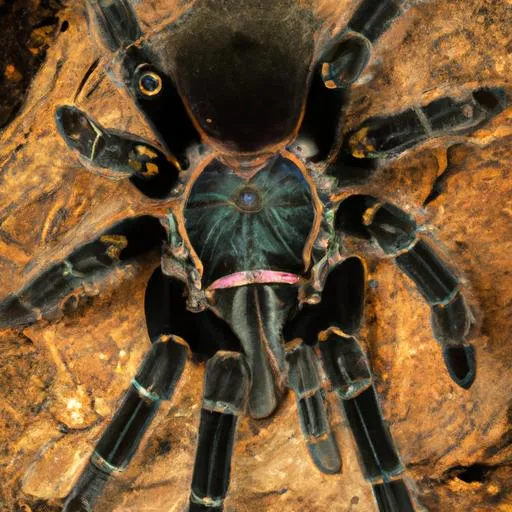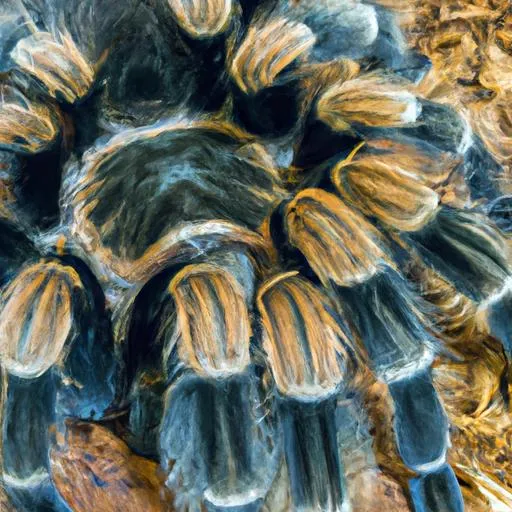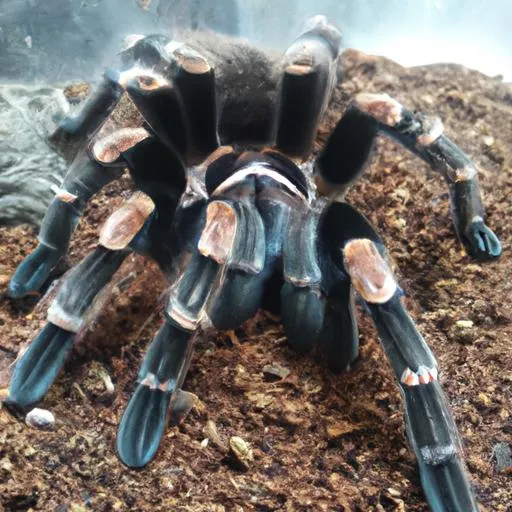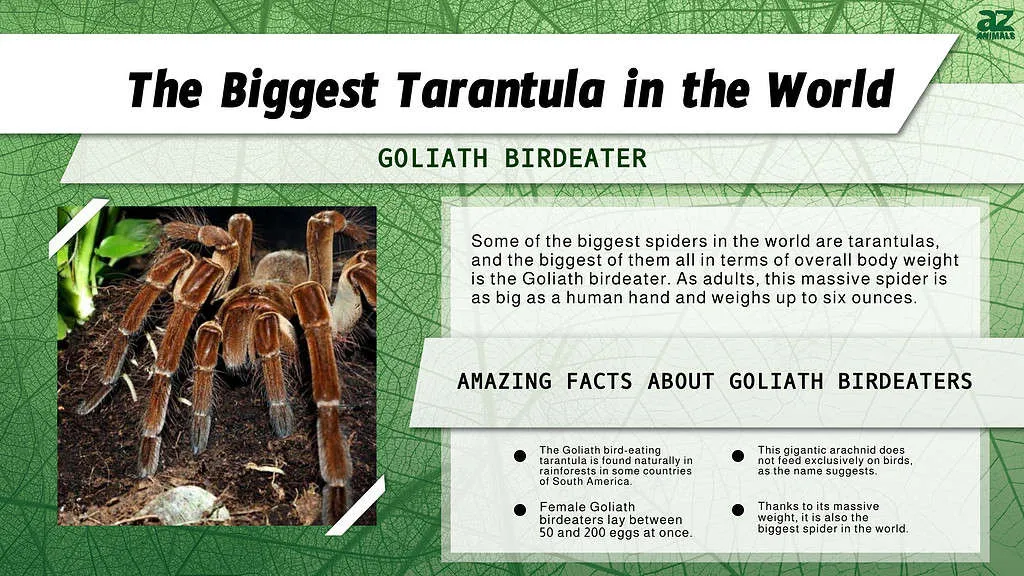What is the Biggest Tarantula Size?
When it comes to the arachnid world, size definitely matters, and no creature embodies this better than the tarantula. These impressive spiders, known for their hairy bodies and formidable fangs, can reach sizes that are genuinely astonishing. Determining the biggest tarantula size isn’t as simple as measuring a single specimen; rather, it’s about understanding the averages, the maximum recorded sizes, and the factors that contribute to a tarantula’s growth. Several species compete for the title of the world’s largest, and understanding their characteristics is key to appreciating the true scale of these giants. We’ll delve into the details, comparing different species and exploring what makes them so big.
The Goliath Birdeater Tarantula (Theraphosa blondi)
The Goliath Birdeater Tarantula (Theraphosa blondi) often takes the top spot when discussing the biggest tarantula size. This South American species is a true behemoth, with a leg span that can exceed 12 inches (30 cm) and a body length of up to 4 inches (10 cm). While the name might suggest a diet of birds, these tarantulas primarily feed on insects, small mammals, and occasionally, the unfortunate bird. Their sheer size is a testament to the wonders of nature, making them a fascinating subject for study and observation. Their imposing presence has earned them a place in the hearts of arachnid enthusiasts worldwide, solidifying their status as the biggest tarantula size.
Size and Characteristics

The Goliath Birdeater’s size is not just about the length of its legs. Their entire body is robust and heavily built, covered in dense hairs that provide sensory information and defense. The fangs of a Goliath Birdeater are also notable, reaching up to an inch long. These fangs are primarily used to inject venom, which is potent enough to subdue their prey. Their overall appearance is intimidating, with a dark brown coloration that blends well with their natural habitat. Their sheer size is a result of successful adaptation and efficient resource management. It’s important to remember that the size can vary based on the individual tarantula, the environment and availability of food.
Habitat and Distribution
These giant spiders are native to the rainforests of northern South America, specifically in countries like Guyana, Suriname, and French Guiana. They prefer humid environments and typically live in burrows, often near swamps or marshy areas. Their habitat plays a crucial role in their size, as the availability of prey and the consistency of the climate contribute to their growth and overall well-being. Their burrowing behavior is a key survival strategy, providing shelter from predators and extreme weather conditions. Understanding their habitat is key to appreciating their size and the importance of their survival in the wild.
Diet and Feeding Habits
Despite their name, Goliath Birdeaters rarely eat birds. Their diet consists primarily of insects, such as crickets and beetles, but they are also opportunistic predators, occasionally consuming small mammals, lizards, and snakes. Their hunting strategy involves ambushing prey, using their powerful fangs to deliver a venomous bite. The venom paralyzes the prey, allowing the tarantula to consume it. The tarantula’s diet is essential to their growth, and a diet rich in protein and nutrients is crucial in achieving their impressive size. Captive Goliath Birdeaters are typically fed a varied diet to mimic their natural feeding habits and ensure their health.
The Heteroscodra maculata (Togo Starburst Baboon)

While the Goliath Birdeater often grabs the headlines, other tarantula species are also contenders for the title of ‘biggest.’ The Heteroscodra maculata, more commonly known as the Togo Starburst Baboon, is another noteworthy species. Although not as large as the Goliath Birdeater, this tarantula still boasts an impressive size and exhibits unique characteristics that set it apart. Its striking appearance, combined with its potent venom, makes it a fascinating species to study and observe. The Togo Starburst Baboon is a reminder that the world of tarantulas is diverse and filled with remarkable creatures.
Size and Characteristics
The Togo Starburst Baboon typically has a leg span that can reach up to 6-7 inches (15-18 cm), and their bodies are covered in striking patterns of black and white or yellow. Their bodies are not as bulky as the Goliath Birdeater, but they are still considered large tarantulas. They possess potent venom and are known for their defensive behaviors, making them a less desirable choice for novice tarantula keepers. Understanding their physical characteristics is crucial to appreciating their adaptations and the challenges they face in their natural environment.
Habitat and Distribution
The Togo Starburst Baboon is native to the tropical forests of West Africa, primarily in countries like Togo and Ghana. They are arboreal tarantulas, which means they spend most of their time in trees. They create intricate webs and nests in tree trunks and branches, using these structures to capture prey and provide shelter. Their habitat preferences and behavior set them apart from terrestrial tarantulas, and they are an essential part of the ecosystems where they live. Their arboreal lifestyle also makes them a challenge to study and observe in their natural environments.
Behavioral Traits

The Togo Starburst Baboon is known for its defensive behavior. They are fast-moving and can deliver a painful bite if threatened. They are also known to flick urticating hairs as a defense mechanism, which can cause skin irritation. This behavior is a crucial adaptation for survival. Understanding their behavioral traits is essential for anyone interested in keeping or studying these tarantulas. Providing them with appropriate habitats and respecting their defensive behaviors is crucial for responsible care.
Other Giant Tarantulas
Several other tarantula species also achieve impressive sizes, competing for the title of the world’s largest. These species, while not always reaching the extreme sizes of the Goliath Birdeater, are still remarkable in their own right and showcase the diversity within the tarantula family.
Grammostola anthracina
The Grammostola anthracina, also known as the Brazilian Black Tarantula, is a popular choice among tarantula keepers. This species is known for its docile temperament and impressive size. While not as large as the Goliath Birdeater, they can still reach a leg span of up to 8 inches (20 cm). Their dark coloration and gentle nature make them a favorite for both beginner and experienced hobbyists.
Lasiodora parahybana

The Lasiodora parahybana, or the Brazilian Salmon Pink Birdeater, is another notable species known for its impressive size. With leg spans that can exceed 10 inches (25 cm), these tarantulas are certainly contenders for the title of ‘biggest.’ Their salmon-pink hairs and relatively docile nature make them popular choices for those looking to keep a large tarantula. Like other large species, they require a spacious enclosure and a diet rich in insects.
Important Considerations about Tarantula Size
Understanding the size of tarantulas involves more than just measuring their leg span. Several factors influence the size that a tarantula will reach, and it’s essential to consider these factors when studying or caring for these creatures. These considerations impact their well-being and growth potential.
Lifespan and Growth
Tarantulas, particularly the larger species, have relatively long lifespans compared to other insects. Females tend to live longer than males, often reaching 10-25 years, while males typically live for only a few years after reaching maturity. Their growth is a process of molting, where they shed their exoskeleton and grow into a new one. The frequency of molting decreases as the tarantula ages. The speed of growth and overall size are heavily influenced by the availability of food, the temperature, and the humidity in their environment.
Handling and Safety

While some tarantula species are relatively docile, handling any tarantula should be done with caution. Their size and potential for venomous bites mean that it’s important to be aware of their defensive behaviors. It’s essential to handle them with gentle movements and avoid sudden actions that could startle them. It’s generally recommended to avoid handling tarantulas unless necessary. If handling is required, it should be done close to the ground to minimize the risk of injury if the tarantula falls. Understanding the tarantula’s temperament is critical for the safety of both the keeper and the spider.
Conclusion
The biggest tarantula size is a fascinating topic that showcases the diversity and wonder of the arachnid world. While the Goliath Birdeater often takes the spotlight, other species like the Togo Starburst Baboon and the Brazilian Salmon Pink Birdeater are also impressive in size. Understanding the size of these tarantulas involves not only measuring their leg spans but also considering factors like their habitat, diet, and behavior. Responsible care and a deep appreciation for these creatures are crucial for their conservation and well-being. As we continue to explore the natural world, the biggest tarantulas will remain a symbol of the grandeur and diversity that nature has to offer.
